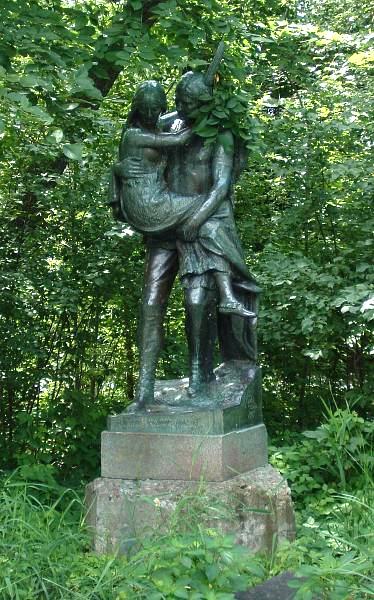|
Jacob Fjelde
Jakob Henrik Gerhard Fjelde (10 April 1859 – 5 May 1896) was a Norwegian-born American sculptor.Harris, Moira F., ''Monumental Minnesota: A Guide to Outdoor Sculpture'', Pogo Press, 1992, pg. 6 He is remembered as both a prolific portraitist and the creator of public monuments. One of his better known works is the one dedicated to the 1st Minnesota Infantry (1897) located at Gettysburg Battlefield where its 262 members suffered 215 casualties. Background Jakob Henrik Gerhard Fjelde was born at Ålesund in Møre og Romsdal, Norway. His father, Paul Gerhard Michelet Fjelde (1827–1873), was a skilled carpenter and wood carver. He had moved to the United States in 1872, but died the following year. Jakob Fjelde was a pupil of Brynjulf Bergslien during 1878. He studied at the Academy of Fine Arts in Copenhagen from 1879 to 1881 and was a student of Vilhelm Bissen 1880–1882. He travel abroad, living in Rome from 1882 to 1884. Fjelde lived and worked to Bergen, Norw ... [...More Info...] [...Related Items...] OR: [Wikipedia] [Google] [Baidu] |
Gettysburg Battlefield
The Gettysburg Battlefield is the area of the July 1–3, 1863, military engagements of the Battle of Gettysburg within and around the borough of Gettysburg, Pennsylvania. Locations of military engagements extend from the site of the first shot & at Knoxlyn Ridge on the west of the borough, to East Cavalry Field on the east. A military engagement prior to the battle was conducted at the Gettysburg Railroad trestle over Rock Creek (Monocacy River tributary), Rock Creek, which was burned on June 27. Geography Within of the Mason-Dixon line, Maryland/Pennsylvania state line, the Gettysburg battlefield is situated in the Geology of Pennsylvania#Gettysburg-Newark Lowlands, Gettysburg-Newark Basin of the Pennsylvania Regions#Pennsylvania Piedmont, Pennsylvania Piedmont entirely within the Potomac River Watershed near the Marsh and Rock creeks' triple point with the Susquehanna River Watershed (near Oak Hill) occupying an area . Military engagements occurred within and around the ... [...More Info...] [...Related Items...] OR: [Wikipedia] [Google] [Baidu] |
Sven Oftedal
Sven Oftedal (March 22, 1844 – March 30, 1911) was a Norwegian American Lutheran minister. He served as the 3rd president of Augsburg University and helped found the Lutheran Free Church. Background Sven Svensen Oftedal was born in Stavanger, Norway. He was the son of Sven Larsen Oftedal (1812-1883) and Gunhild Omundsdatter Stokka (1809-1881). His father was a teacher at the Stavanger Cathedral School. His elder brother Lars Svendsen Oftedal (1838 –1900) was a Norwegian priest and social reformer. He was also the founding editor of ''Stavanger Aftenblad '' and served as a Member of the Storting. He graduated from Stavanger Cathedral School in 1862. He studied at the University of Oslo and earned his theology degree in 1871. He also studied languages, philosophy, and theology at several other European universities. Career He came to Minneapolis, Minnesota in 1873 to serve as a professor of the New Testament at Augsburg Seminary, predecessor to Augsburg University. ... [...More Info...] [...Related Items...] OR: [Wikipedia] [Google] [Baidu] |
The Song Of Hiawatha
''The Song of Hiawatha'' is an 1855 epic poem in trochaic tetrameter by Henry Wadsworth Longfellow which features Native American characters. The epic relates the fictional adventures of an Ojibwe warrior named Hiawatha and the tragedy of his love for Minnehaha, a Dakota woman. Events in the story are set in the Pictured Rocks area of Michigan on the south shore of Lake Superior. Longfellow's poem is based on oral traditions surrounding the figure of Manabozho, but it also contains his own innovations. Longfellow drew some of his material from his friendship with Ojibwe Chief '' Kahge-ga-gah-bowh'', who would visit at Longfellow's home. He also had frequent encounters with Black Hawk and other Sauk people on Boston Common, and he drew from ''Algic Researches'' (1839) and other writings by Henry Rowe Schoolcraft, an ethnographer and United States Indian agent, and from ''Heckewelder's Narratives''. In sentiment, scope, overall conception, and many particulars, Longfellow insi ... [...More Info...] [...Related Items...] OR: [Wikipedia] [Google] [Baidu] |
Henry Wadsworth Longfellow
Henry Wadsworth Longfellow (February 27, 1807 – March 24, 1882) was an American poet and educator. His original works include "Paul Revere's Ride", ''The Song of Hiawatha'', and ''Evangeline''. He was the first American to completely translate Dante Alighieri's ''Divine Comedy'' and was one of the fireside poets from New England. Longfellow was born in Portland, Maine, which was then still part of Massachusetts. He graduated from Bowdoin College and became a professor there and, later, at Harvard College after studying in Europe. His first major poetry collections were ''Voices of the Night'' (1839) and ''Ballads and Other Poems'' (1841). He retired from teaching in 1854 to focus on his writing, and he lived the remainder of his life in the Revolutionary War headquarters of George Washington in Cambridge, Massachusetts. His first wife, Mary Potter, died in 1835 after a miscarriage. His second wife, Frances Appleton, died in 1861 after sustaining burns when her dress caught ... [...More Info...] [...Related Items...] OR: [Wikipedia] [Google] [Baidu] |

